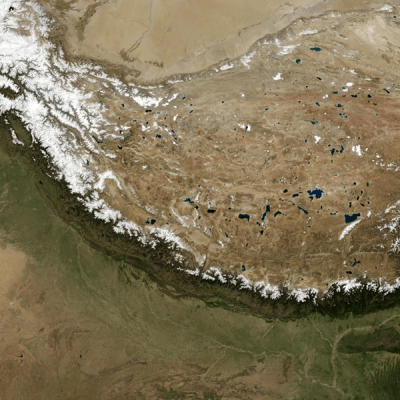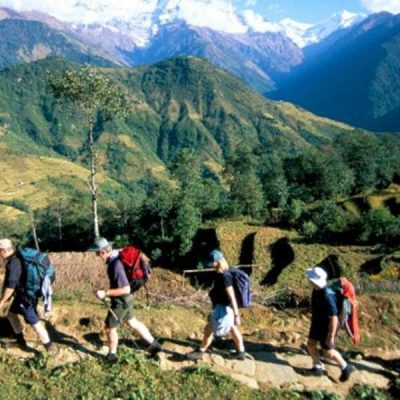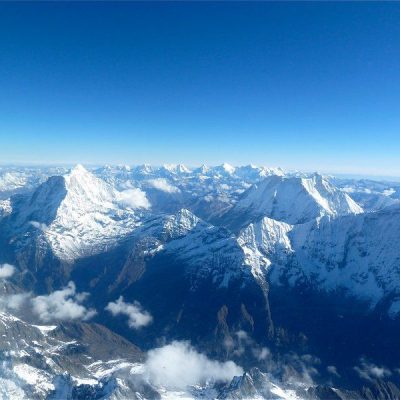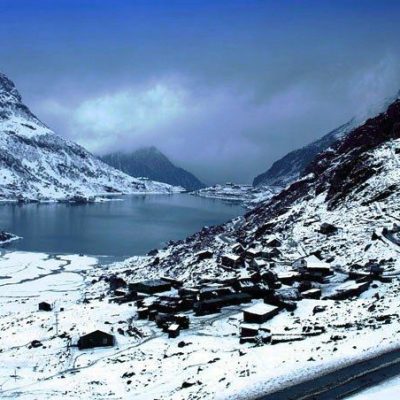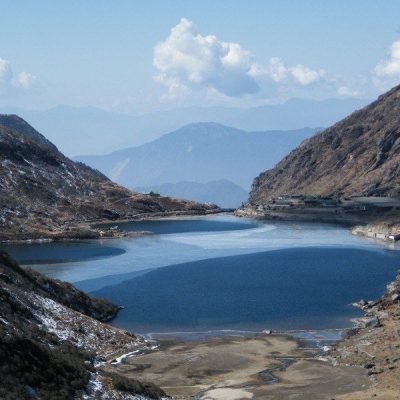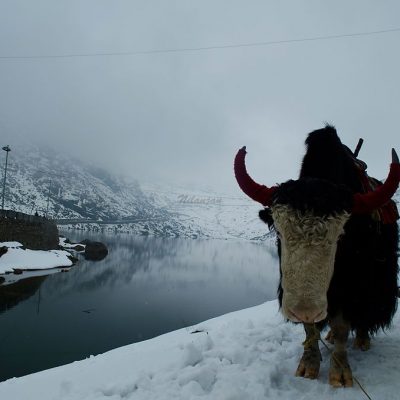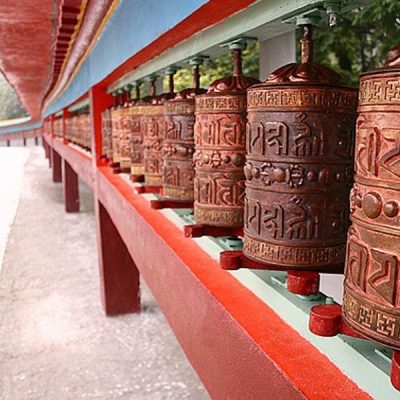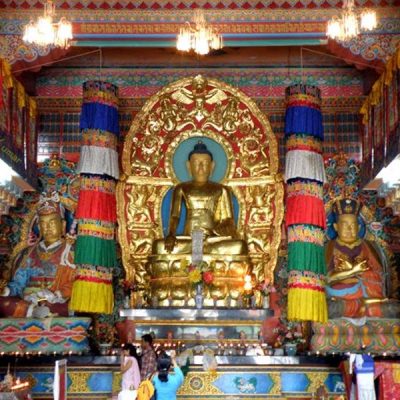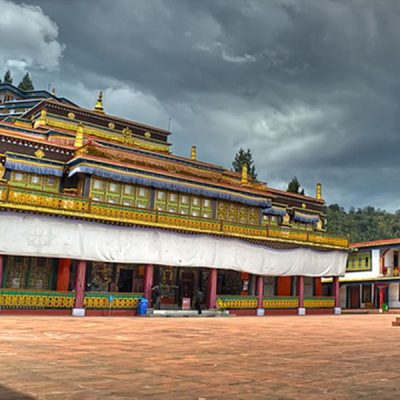Sikkim and Bhutan
14 Days
ABOUT THE ITINERARY
This itinerary is basically designed as to experience and visit the holy sites of Sikkim and Bhutan that were blessed by Guru Padmasambhava. Sikkim and Bhutan contain many sacred sites blessed by Guru Rinpoche during his long journey from India to Tibet in the 8th Century CE. While traveling between Gangtok, Pemayangtse, Paro and Taktshang you can discover several monasteries built to commemorate these places. You will start the journey enjoying the cultural delights as you pass through small villages and tea gardens on your drive from the plains of Bagdogra up towards Namchi as the gentle climb opens up new vistas in each turn and bend. From here you will enter the Indian state of Sikkim, located in the lap of the Himalayas and sandwiched between Nepal Bhutan and Tibet in a small stretch of rugged land just 40 miles by 70 miles.
The perennially snow-capped mountains, lush green tropical and temperate forests, gurgling streams and the rich flora and fauna – a true Shangrila or “Nye-mae-el” which simply means ‘heaven’. Embarking on a journey to Sikkim will bring you to discover a mystical wonderland of spectacular natural beauty. The panoramic perfection of the Himalayas, the heady scent of flower-bedecked meadows, the vibrant culture and joyous festivals, the infinite variety of its flora and fauna makes it a holiday that is at once fascinating and challenging. The ancient monasteries and holy stupas that awaits you in Sikkim is a testimony to the rich Buddhist heritage of a land that has been blessed by Guru Padmasambhava.
From Sikkim the itinerary will grant you a privileged access to the holiest Buddhist sites in Bhutan. Perched high on the mighty Himalayan range, the Kingdom of Bhutan has defied globalization and chosen to remain a hidden paradise. This is a place that even seasoned travellers consider a privilege to visit.
Bhutan, unlike its other Himalayan neighbours, considers all creation sacred, including trees, mountains, rivers, and lakes. Consequently, Himalayan species near extinction in the bordering countries of Nepal, India, and Tibet are doing well in Bhutan. Bhutan is also the last bastion of vajrayana Buddhism, a spiritual practice that is known to be one of the most profound schools of teaching in the Buddhist world. The sacred monasteries, the fluttering prayer flags that line the high ridges, the red robed monks chanting their prayers — all give this kingdom an aura of another time.
This is BHUTAN: Known to its inhabitants as Druk Yul — “the Land of the Thunder Dragon. The culture remains vibrant and the environment pristine as Bhutan continues to thrive in the 21st-century. Apart from the majesty and grandeur of the natural surroundings, the environment allows communion with the divine through meditation and contemplation. Bhutan is an abode of Buddhist deities, immortals, and saints in the Himalayas. Scholars wandering yogis, saints and lay pilgrims, have been irresistibly drawn to these remote and rugged mountains throughout the centuries in their search for wisdom and inspiration. Experience the landscapes they have blessed for all pilgrims by following in their footsteps. As you travel to these hidden holy shrines and otherworldly ancient monasteries (Gompas), hiking through an unspoiled Himalayan environment, you will rediscover this peace and solitude.
The scared Paro Taktshang, Tiger Nest is blessed during 7th century, by the great tantric master, Guru Rinpoche, who came here by his miraculous, flying on the back of flaming tigress in form of Guru Dorje Drolo from Khenpajong (eastern Bhutan) on the way from Tibet, to advocate the Buddhism teaching in Mon-Yul (place of darkness). Here, he meditated almost three months and blessed with numerous of Neys (holy site), subdued and activated the evil deities as Buddhism protectors and even the whole locality were also turned into Buddhist. From Pemayangtse monastery, meaning perfect sublime lotus, the beautiful Khachopelri monastery, the unique Bon Monastery of Kewzing and finally to the famous, majestic Tiger’s Nest (Taktsang) balanced among the clouds high above Paro, blessed by Guru Padmasambhava himself, this journey provides a true insight to the rich culture and religiousness of Sikkim and Bhutan.
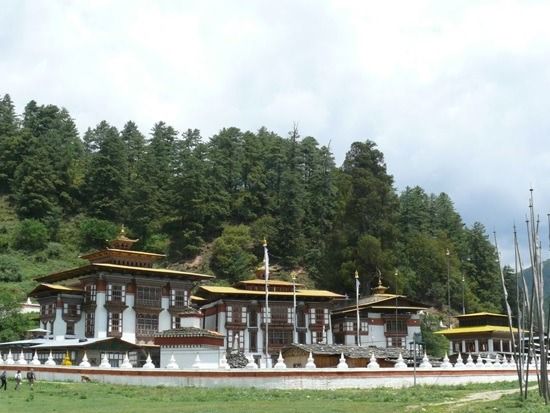
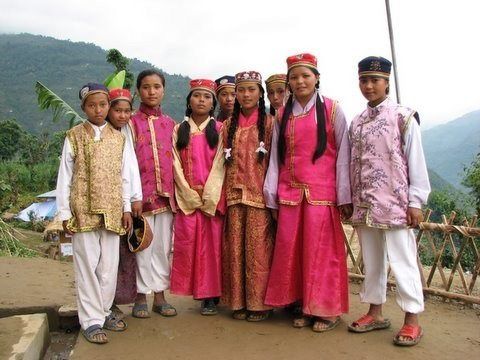
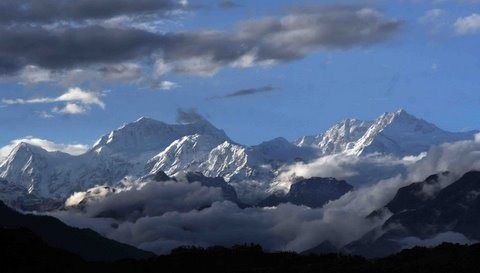
SIGN UP FOR THE TRIP
Registration can be requested for group travel or for self-travel. For group travel, registration is not binding. Upon reaching the minimum number of members necessary for the formation of the group, usually 4 or 6 people, you will be asked for confirmation of booking and payment of a deposit.
JOURNEY OVERVIEW AND PROGRAM DETAILS
1° Day: ARRIVAL IN KOLKATA
Kolkata
Arrival at Calcutta international airport. Transfer to hotel for refreshing and rest. Kolkata, formerly Calcutta, is the capital of the Indian state of West Bengal. Located on the east bank of the Hooghly river, it is the principal commercial, cultural, and educational centre of East India, while the Port of Kolkata is India’s oldest operating port as well as its sole major riverine port. As the former capital of British India, Kolkata retains a feast of colonial-era architecture contrasting starkly with urban slums and dynamic new-town suburbs with their air-conditioned shopping malls. Afternoon short city tour which also includes a country boat ride on the Ganges to experience the glorious sun set.
Overnight in Kolkata (B)
2° DAY: TRASNFER TO BIKSTHANG
Kolkata – Bagdogra – Namchi
In the morning, transfer to the airport and flight for Bagdogra. Arrive in Bagdogra airport and transfer to Namchi, a bustling commercial town, will take around three hours and you will be here for an overnight stay. At around dusk, you will have the chance to visit the enormous Char Dham Temple sitting above the town. Here you will enjoy a memorable puja ceremony in an unusual setting to round off your Himalayan adventure.
Overnight in Namchi. (B, D)
3° Day: MONASTERY VISIT PELLING
Namchi – Pelling
After breakfast transfer to Pemayangtse or Pelling (around 2 hours drive), situated at an altitude of 1,900 m (6,250 ft) and the last motorable destination towards Mt. Kanchenjunga. This village is the third highest peak in the world and the most important centre of Tantric Buddhist culture introduced by Guru Rimpoche. You will visit to Pemayangtse monastery (which means perfect sublime lotus) one of the oldest and most important monasteries of Sikkim. Later you will visit the beautiful Khachopelri monastery and lake. Khecheopalri Lake is considered one of the sacred lakes of Sikkim and it remains hidden in the rich forest cover. It is believed that birds do not permit even a single leaf to float on the lake surface, maintaining the sanctity of the place by being silent, and by not trying to feed the fish. Situated on a ridge above Pelling and overlooking the famous Pemayangtse Monastery, there is one of the most important monasteries of Sikkim, the Sangachoeling. In the evening you will attend a workshop/meditation at a Lama’s house.
Overnight in Pelling. (B, D).
4° Day: TRANSFER TASHIDING-RINCHENPONG
Pelling -Tashiding – Rinchenpong
Early morning transfer for a trip to Tashiding, a small village on a hilltop near Pelling. The Tashiding monastery (which means The Devoted Central Glory) belongs to the Nyingmapa order and it is highly revered among the people of Sikkim. Build on the top of the hill and looming over the Rathong and Rangit River, the monastery can be seen from far and wide. It is believed that even a slight glimpse of the monastery can cleanse mortals of all sins. Later proceed further to Rinchenpong, a Lepcha village in West Sikkim. Check in at the charming heritage farm Yangsum Farm run by a local family. The outfit has excellent facilities and clear view of snow peaks. Moreover, you will soak into the authentic and intimate Sikkimese hospitality and local culture. After lunch enjoy a walk around the farm or to the Lepcha village.
Overnight at Yangsum Heritage Farm. (B, L, D).
5° Day: VILLAGE VISIT AT HEE BERMIOK
Rinchenpong – Hee Bermiok- Rinchenpong
Transfer to Hee Bermiok, West Sikkim. Bounded by Kalez Khola in the North, Hee Khola in the West, Rangit Khola in the East and Samdong reserve Forest in the South, Hee Bermoik village in West Sikkim has a beautiful setting. Apart from many scenic spots, the area has a good deal of flora and fauna. More than 65 species of birds have been located in the surroundings. Though dominated by the Limboo community, large number of Chettris, Bahuans, Sherpas, Tamang, Bhutias, Lepchas, Rais and Gurungs of Nepali community live here. They have their own distinct religious and cultural heritage. Today you will have a village walk as to enjoy a real community experience, watching the lifestyle of village with Limbo traditional houses. You will also have the chance to meet a spiritual leader who will explain you the bio-divinity practiced by the local tribes. In the late afternoon we visit Reshi, where we can spend some time relaxing in a blissful natural hot water spring which will relieve each and every muscle of your body. The Reshi Hot Water Spring holds a special stature due to its location and religious significance. It is also believed to have natural medicinal properties. Owing to the high quantity of Sulphur in the water, a peaceful dip in the lagoon is said to cure skin diseases and restore your vitality.
Overnight in Yangsum Heritage Farm. (B, L, D)
6° Day: MONASTERY VISIT KEWZING
Rinchenpong- Kewzing-Rumtek
After breakfast set out for a half day excursion to Kewzing in South Sikkim to visit the monastery of followers of Bon religion from Tibet. The Bon Monastery here is the only one of its kind in Sikkim and it is a symbol of the determination of a community to preserve their religious traditions. After lunch you will be transferred to Rumtek. From here check in village resort near Rumtek monastery. A stay at this village Resort is all about experiencing the natural beauty of the area. Spend the rest of the day enjoying the quiet, scenic surroundings on walks around the rice terraces, or chill out at this humble, laidback property. Overnight in Rumtek. (B, D).
7° Day: visit Rumtek
Rumtek- Doars
Walk to Rumtek Dharmachakra monastery, the headquarter of Karmapa. The monastery is currently the largest in Sikkim. It is home to the community of monks and where they perform the rituals and practices of the Karma Kagyu lineage. A Golden Stupa contains the relics of the 16th Karmapa. Later you will visit the Namgyal Institute of Tibetology, Directorate of handicrafts and hand loom and the local market. After an early lunch and leave for a forest resort in Doars. (around 4 hours). Refreshments will be served upon arrival. Check-in to the room. Later Embark on an evening jungle safari in Gorumara National Park to view some of the wildlife inhabiting the region – one-horned Indian Rhino, Elephant, Gaur (Indian Bison) as well as a variety of endemic and migratory birds. After the jungle safari return to the hotel for dinner.
Overnight in Doars (B, D)
8° Day: TRANSFER THIMPU
Doars- Phuentsholling- Thimphu
Early breakfast followed by a short community visit in the Rabha tribal village. Transfer to Phuentsholling border from where our Bhutanese guide will meet you. Travel to Thimpu (175km about 5 hrs). Leaving the city of Puntsholing you will heading towards cool and clean air, the road climbs to a higher elevation as you will experience the thin air of the high Himalaya, drive pass Kharbandi Gomba, overlooking the border town of Jaigon and Puntsholing. In a couple of hours drive you will reach Chhukha. There you will see hydro projects, which generates 1020MW of electricity by the Wang Chhu River. You will come across the immigration check point before you climb the Chapcha Village. After crossing the pass, the road drops quickly and follows the upper Wangchhu river, after which your drive becomes much comfortable with a two-lane road till Thimphu. (2280m)
Overnight in Thimpu. (B, L, D).
9° Day: visit Thimpu
Thimphu
Today you will make a visit to “CTAS” Choki Traditional Art School. The main mission of the school is to preserve the traditional arts and crafts of Bhutan from fading away and to empower youth with livelihood skills. You can visit their classes and interact with students and teachers, you can also try their arts and craft while at class. Transfer to the hotel. After refreshment short drive to giant Buddha point, later scenic drive to mini zoo, where Bhutan national animal is preserved: the Takin (Budorcas Taxicolor). This is one of the larger and stockier of the goat antelope, plump, bovine like body which is covered with dense long yellow to brown hairs. Free evening to walk to an authentic craft market and to handicraft emporium.
Overnight in Thimpu. B/L/D.
10° Day: TRANSFER PUNAKHA
Thimphu-Punakha
Morning transfer to Punaka (about 3hrs, 77 km). Start your drive through a forest of pine and hemlock, festooned with hanging lichens high up Dochula pass. This pass offers panoramic views of the Himalayan Mountain ranges, you will make 1hr hike down on Dochula nature trail. As you descend along a series of curve road to the fertile valley of Punakha. Before proceeding further to Punakha town, we will take a short 45 minutes’ walk to Chimi Lakhang a temple on a small hill top. This temple is dedicated to the great yogi of 14th century, known as Drukpa Kuenly or popularly called the “Divine Madman”. Transfer to the hotel in Punakha (1250m).
Overnight in Punakha. B/L/D.
11° Day: VISIT PARO
Punakha-Paro
Early morning transfer to Paro (about 4 ½ hours, 130km). You will visit the majestic Punakha Dzong, built in between PhoChu and MoChu, (male & female) river. Start your drive climbing to great Dochula pass, from where you will have again the chance to view the great Himalayan ranges, stop at cafeteria for some rest, enjoying an hot tea or coffee. After break continue for Thimphu, spend some time for last minute shopping and photo at traffic police directing cars, After refreshment transfer to Paro (1 ½ hr). Check in the hotel.
Overnight in Paro. (B, L, D).
12° Day: HIKE TAKSANG (TIGER NEST)
Paro-Taksang-Paro
Day Hike to Taksang (Tigers Nest). Start the day with short drive to Paro’s upper valley. On a clear day you will have an unforgettable view of the Mount Chomolhari at 4.150 metres of altitude. The mountain is sacred to Tibetan Buddhists who believe it is the abode of one of the Five Tsheringma Sisters: (jo mo tshe ring mched lnga) — female protector goddesses (Jomo) of Tibet and Bhutan, who were bound under oath by Guru Padmasambhava to protect the land, the Buddhist faith and the local people. Afterward, with a short drive short drive you will reach Taksang trail head. From here you will Hike to Taksang Monastery, the most famous monastery of Bhutan. Taksang means “Tiger Nest” so named because Guru Rinpoche reportedly flew to the site on the back of a flying tiger late in the 8th century. Between blue pines and a blue sky, the monastery perches miraculously on a cliff nearly 900 metres above Paro’s valley floor. Break along the way for tea and snacks in small tea house. Descend in distilled afternoon light to eat a delicious dinner.
Overnight in Paro. (B, L, D).
13° Day: MEDITATION DONGKOLA MONASTRY
Paro – Dongkola Lhakhang – Haa
After breakfast drive (about 2 hours) to Dongkola Monastry where you can meet the monks. There will be an offering and after ceremony visit the main temple. After the ceremony join the monks for lunch and later you can join the monks in temple cleaning activity. Late afternoon you will have a chance to have a meditation session with the monks. In the evening, return to Paro.
Overnight in Paro (B, L, D).
14° Day: depart Paro
Paro
Say goodbye to Bhutan and board a flight for onward destinations.
ACTIVITIES
- enjoy the spectacular views of Mt. Kanchenjungha
- experience Limboo culture and hospitality of Hee Bermiok’s communities
- visit the most important centre of Tantric Buddhist culture of Sikkim, introduced by Guru Rimpoche, and learn about Tantric Buddhism
- relax in a blissful natural hot water spring
- take part in meditation workshop in a lama’s House
- soak into the authentic and intimate Sikkimese hospitality
- walk in a Lepcha Village
- observe Hydro-electric projects on the Wang Chhu river
- take part in art and crafts activities in Choki Traditional Arts School
- Enjoy a jungle safari in Gorumara National Park
- see the Takin, the national animal of Bhutan preserved in a zoo in Thimphu
- visit hand-made paper factory
- interact with monks and teachers of Tango Buddhist university of higher studies to exchange their views on their way to monkhood
- walk down on Dochula nature trail
- day Hike to Taksang, the famous Tigers Nest, enjoying unforgettable views of the Mount Chomolhari
- Participate for a full day in the activities of monks in Dongkola Monastry,
- visit temples and monasteries
HIMALAYAN RANGES
The picturesque valleys laden with over 200 species of orchids and rhododendron forests and relatively mild treks into pristine Himalayan ranges and the stunning Kanchendzonga makes Sikkim alluring as a popular honeymoon destination in India especially during Summer. At Ravangla where the only tea estate of Sikkim is located, honeymooners could found a blissful escape surrounded in shroud of greenery lorded over by the mighty Kunchendzonga peak.
LAKES
One of the top places to visit in Sikkim also includes Tsogmo Lake, a high altitude lake with towering Himalayas in the backdrop.
The lake remains frozen during winters but one could still visit it and enjoy hot sip of tea and momos on the frozen lake. Yet another important lake to visit in Sikkim is the Gurudongmar Lake.
MONASTERIES
For religious and cultural interactions, one could visit Rumtek Monastery, one of the most important centers of Tibetan Buddhism and a repository of ancient and medieval artifacts. Rumtek Monastery also happens to be the official seat of the Karmapa Lama.
SOCIAL AND ENVIRONMENTAL IMPACT
All the itinerary has been designed in order to promote direct or indirect benefits for local communities, environment and cultural heritages. When possible, we have selected traditional accommodations sensible to social and environmental issues, following general principles and practices of responsible tourism.
The tour is designed to include the activities of various local and tribal communities, through the use of a number of local homestays which get economic support from the trip. In particular, in Biksthang you will experience traditional Sikkimese hospitality being host in family farm guest-house which has a sprawling organic farm and garden; in Hee Bermiok you will stay at Yangsum farm resort, an authentic farm resort, where you could discover the Limboo community culture and tradition. This is a joint initiative of Sikkim Tourism, Help Tourism, a community based tourism company, the Association for Conservation and Tourism (ACT), Hee Patal village and Tamling Nursery. The project offers an unique opportunity to enjoy an authentic community experience, watching the lifestyle of village with Limbo traditional houses, having the chance to meet a spiritual leader who will explain you the bio-divinity practiced by the local tribes. This jungle camp has been created as to create a source of funding for social, cultural and economic development of the areas. The last night in Sikkim, before entering the state of Bhutan, you will stay at Doars Jungle resort, an abode for those who appreciate an authentic, educative and inspiring experience with the local nature and culture. Here you will have a chance to experience a jungle jeep safari..In Thimpu, the capital of Bhutan, the tour will support the CTAS “Choki Traditional Art School”, whose main mission is to preserve the traditional arts and crafts of Bhutan from fading away, and to empower youth with livelihood skills. This school is the only private institute providing training on traditional arts and crafts in Bhutan. It provides free tuition, food and lodging facilities to the economically disadvantaged youth of Bhutan. By teaching and promoting traditional skills of Bhutan the institute has high potential to create new jobs. Zorin Chusum (Thirteen Crafts) can provide a real source of income and employment.
In Thimpu you will also visit a Voluntary Artists’ Studio, known as VAST, which was set up in 1998 by a group of professional artists as a non-profitable and non-governmental organization (NGO). This informal organization was set up with the sole aim of providing an opportunity to the Bhutanese youth to participate and develop their potential talents as well as share social responsibilities through artistic explorations and other socially useful and productive work. Its primary objective is to provide potential vocational skills and alternative positive use of free time and facilitate participation in the national and international art realm. You will have an exposure visit to the youth centenary village, part of “Simply Bhutan”, an unique project of the Bhutan Youth Development Fund. This institution runs programs in order to build leadership skills, encourage teamwork and promote the value of service among youth. Through advocacy work and strategic partnerships, the Fund works to encourage youth participation, raise awareness of youth issues and promote youth-oriented policy. We invest in Bhutan’s future, one youth at a time.
TIPS BEFORE DEPARTURE
A conscious approach to travel requires a considerable capacity and willingness to adapt and adjust to the local environment and culture. If you wish to travel with us we request you to be open enough to experience local culture, religious and traditions without bias and pre-conceived ideas you might have before the departure and which belong to our Western cultural way of thinking.
Exploring with fresh eyes, with patience and openness, you will be able to access the real essence of the cultural heritages and spirituality through the places and people you are going to meet; if you are ready to do this effort you will really enjoy the beauty of the rich culture and religiousness of Sikkim and Bhutan, the extraordinary of the nature, the solemnity of Buddhist monasteries and the holy sites blessed by Guru Padmasambhava himself.
In Sikkim and Bhutan the weather could get wet with sporadic or long showers. Please pack appropriate clothing. Bhutan’s changeable climate means you have to bring an assortment of clothes, including rain gear. Mornings and evenings could be quite cold. Carry with you appropriate warm clothing especially for the evening. A layered wardrobe probably makes the most sense. However, warm clothing is required throughout but more specifically from October to April. Good walking shoes or hiking boots are essential even if you are not hiking. Because of the altitude, a hat or cap and a good pair of sunglasses are essential. Because of the long distances between towns and villages bring the medicines you’ll need along with some first-aid supplies. A good flashlight (torch), water bottle and polarizing filter for your camera will also come in very handy. A backpack is necessary to carry essentials/cameras while you are on local excursions. Monasteries and temples are places of worship, so you should be dressed accordingly. Admission might be denied to men and women wearing short pants/skirts, sleeveless t-shirts/blouses.
Getting to Bhutan is not quite straightforward. The Bhutanese Government monitors visitors into and out of Bhutan. Travel within Bhutan is possible only using a recognised agent and with a group visa that will be issued at the border with Sikkim (visa cannot be obtained independently or travel around the country on your own). On entry into Bhutan, you will meet an official recognised guide, who will escort you everywhere. He will be with you until you depart. You are strongly recommended to engage with us at an early stage of you are planning to visit Bhutan during Festival periods.
HOTELS
In Sikkim, when possible we have selected traditional family-run accommodations or community based camps, like Yangsum farm and Doars Jungle resort, or small but excellent heritage resorts with good facilities. Whilst in Bhutan, we have selected higher category and bigger family owned resorts with all the major facilities and comforts but in the true tradition of Bhutanese hospitality.
TRANSPORT
In Sikkim comfortable SUV will be used for transfers and local excursions on 3-4 share basis. In Bhutan comfortable and air-con mini-coach/van.
WHEN TO GO
It is possible to visit Sikkim and Bhutan all year around but the best weather is generally:
Mar – May (spring) / Mid Sep – Mid Nov. (autumn)
Spring (March April & May) is the most beautiful time of the year, resplendent and ablaze with a spectacular array of bright colours. Also, it is the time to witness the famous Paro tsechu festival. The Paro Tshechu is held every spring and is one of the most colourful and significant events in Paro Dzongkhag (district). Autumn (September, October & November) is lovely with clear and crisp blue skies, providing a grand view of some of the tallest unclimbed mountains in the world. It is the best time for trekking and for traveling. This is instead the right time to assist to the Thimphu tsechu festival!


